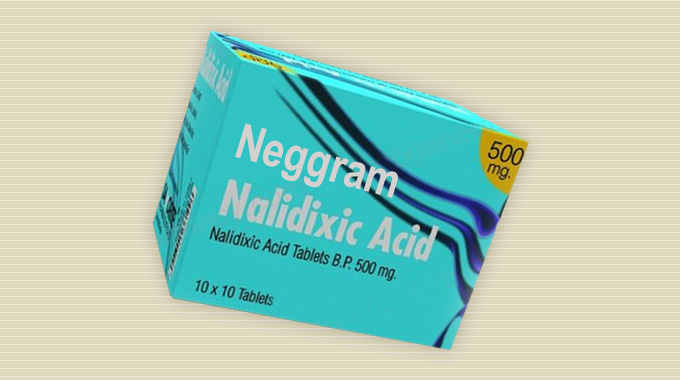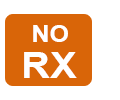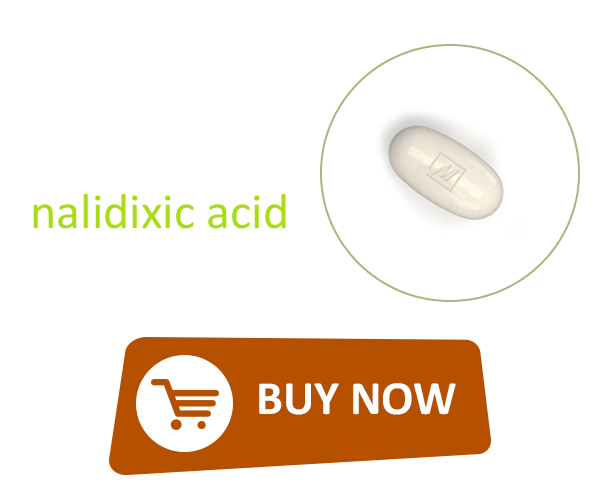Neggram (nalidixic acid)
It is an antibacterial medicine which works by killing the sensitive bacteria. It stops the production of essential proteins needed by the bacteria to grow and survive.

Dosage
The dosage of Neggram (nalidixic acid) can vary depending on the specific condition being treated, the severity of the infection, and the individual patient's medical history. It is important to follow the instructions provided by your healthcare provider or the directions on the prescription label.
For most urinary tract infections, the typical adult dosage of Neggram is 1 gram (1000 mg) taken orally every 6 to 8 hours for 7 to 10 days. However, the dosage may be adjusted based on the type and severity of the infection.
For children, the dosage is usually determined based on their weight. The pediatric dosage of Neggram is typically prescribed as a once-daily dose, with the specific amount determined by the child's weight.
Composition
It is a quinolone antibacterial agent which is used for oral administration. It is a pale yellow, crystalline substance and a very weak organic acid. This medicine contains the following inactive ingredients FD&C Red, Carbomere,Flavor, Purified Water, Parabens, Saccharin Sodium, Sorbitol Solution and Sodium Chloride.
Uses
This medicine is used to treat urinary tract infection.
Side Effects
Neggram is known to cause side effects in some patients. Most of the patients may report minor or no side effects of this medicine. Some of the common side effects are listed below:-
- Weakness
- Drowsiness
- Vertigo
- Sensitivity to light
- Headache
- Unable to focus
- Double vision
- Decreased visual acuity
- Cranial nerve palsy
- Nausea
- Diarrhea
- Abdominal pain
- Vomiting
- Dizziness
- Joint swelling
- Rashes
- Pruritus
- Anaphylactic shock
- Stevens-Johnson syndrome
- Erythema Multiforme
- Urticaria
- Angiodema

Apart from these, there are some rare occurrence of certain side effects such as Cholestasis, thrombocytopenia, seizures, fever, leukopenia and peripheral neuropathy. Allergic reactions or rash was the most commonly reported side effect of this medicine.
Contraindications
As this medicine is known to cause multiple side effects, hence it is important that you let your doctor know beforehand if you have any allergies to this medicine or to any inactive ingredient of this medicine or any other type of allergies. Also, share your medical history with your doctor, especially if you have liver disease, kidney problems, nervous system disorders, blood vessel disorder or if you are prone to seizures. This medicine should be used with carefulnessin patients with severe renal failure. You should avoid excessive sunlight or prolonged exposure to sunlight. In case of phototoxicity, discontinue the medicine and consult your doctor. If you are undergoing chemotherapy, please do not use this medicine. It is always advisable to inform the doctor if you are using any other prescription, non-prescription medicine, dietary supplements or herbal medicines. People with a family history of heartbeat problems should also avoid using this medicine. This medicine can interact with other medicines and hence can reduce their effects or may cause severe side effects in a patient. The safety and effectiveness of this medicine in infants below the age of three have not been proven yet. Also, for patients below the age of 18 the medicine should only be prescribed if the potential benefits outweigh the risks involved. This medicine has shown no adverse effects in elderly people, however, caution should be observed as elder people may have reduced renal function and are more likely to be affected by impaired renal function.
Pregnancy and Neggram
If you are pregnant or plan to have a child, please consult your doctor before using this medicine. It can be found in the breast milk and should be avoided.
Some frequently asked questions about Nalidixic acid
What is nalidixic acid?
Nalidixic acid is an antibiotic medication that belongs to the class of drugs called quinolones. It is primarily used to treat urinary tract infections caused by certain susceptible bacteria.
How does nalidixic acid work?
Nalidixic acid works by interfering with the DNA replication process of bacteria, preventing their growth and reproduction. This helps to eliminate the infection and alleviate the associated symptoms.
What conditions can nalidixic acid treat?
Nalidixic acid is primarily used for the treatment of urinary tract infections, including uncomplicated cystitis and pyelonephritis caused by susceptible bacteria. It is not effective against infections in other parts of the body.
How is nalidixic acid taken?
Nalidixic acid is usually taken orally in the form of tablets. The dosage and duration of treatment will depend on the specific infection, the severity of the condition, and the guidance of your healthcare provider. It is important to take nalidixic acid exactly as prescribed and for the entire duration of the treatment.
Are there any side effects associated with nalidixic acid?
Like any medication, nalidixic acid can cause side effects. Common side effects may include nausea, vomiting, diarrhea, stomach pain, headache, and dizziness. In rare cases, it may cause more serious side effects, such as allergic reactions or tendon inflammation. If you experience any severe or persistent side effects, seek medical attention.
Can nalidixic acid interact with other medications?
Nalidixic acid may interact with certain medications, including antacids, iron supplements, and certain antibiotics. It is important to inform your healthcare provider about all the medications you are currently taking to avoid potential interactions.
Can nalidixic acid be used during pregnancy or while breastfeeding?
It is important to consult with your healthcare provider before using nalidixic acid during pregnancy or while breastfeeding. They can evaluate the potential risks and benefits and provide guidance based on your specific situation.
What should I do if I miss a dose of nalidixic acid?
If you miss a dose, take it as soon as you remember, unless it is close to the time for your next scheduled dose. In that case, skip the missed dose and continue with your regular dosing schedule. Do not double the dose to make up for the missed one.
- Download in PDF » Neggram: Product Information


